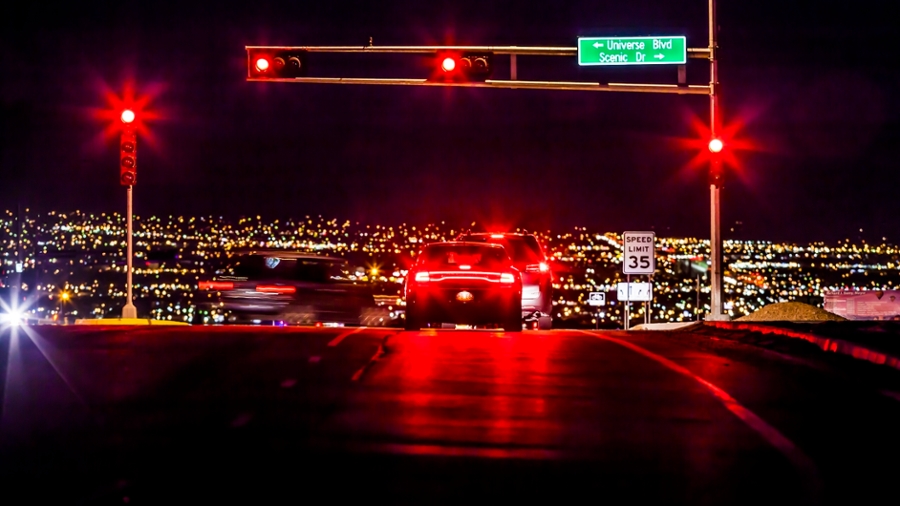School of Engineering experts helping to improve Balloon Fiesta access
April 17, 2019 - Kim Delker

Researchers from The University of New Mexico’s Department of Civil, Construction and Environmental Engineering’s transportation program are offering their expertise to the Albuquerque International Balloon Fiesta to help ease traffic congestion associated with the city’s world-famous event.

Claude Morelli, a research scholar in transportation planning and policy, and assistant professors Gregory Rowangould and Nick Ferenchak are studying ways to improve visitor access to the event, which annually attracts around 900,000 people every October. Their work is supported by two Transportation Program students: Alexis Corning-Padilla and Kasey Gooden. Corning-Padilla is a second-year master’s degree student and Eisenhower Transportation Fellow, while Gooden is an advanced undergraduate who will be starting a master’s degree in the department next fall.
Morelli, who joined the UNM faculty in summer 2018, has an extensive background in multimodal transportation planning, with experience in both the public and private sectors. He has been involved with a wide variety of projects in several states, which range from a traffic mitigation strategy for the Aspen Music Festival to public transit service plans in Colorado and Wyoming resort towns, walkability assessments in Albuquerque and El Paso, and the development of the New Mexico Department of Transportation’s long-range plan.
He initiated the Balloon Fiesta project after seeing media reports about the Fiesta’s traffic issues last fall, thinking that he and his UNM colleagues might be able to lend their expertise to develop solutions. After connections were made, the research proposal quickly took shape. The work started in mid-January and is now about two-thirds of the way through.
“The overarching goal is to help the Balloon Fiesta to develop an integrated, multi-modal transportation strategy to address issues related to traffic, parking, park-and-ride, pedestrians, and other travel modes such as taxis, tour buses, transportation network companies [i.e., Uber, Lyft, etc.], and bicycles in a way that maximizes the quality of the guest experience while also minimizing community impacts,” Morelli said.
The research will provide a foundation for short, medium and long-term actions, some of which can go into effect as early as fall 2019.
“There is a limit to what we can accomplish with this study, but our intent is to apply research-driven awareness to what is possible,” he said.
He said that the development of comprehensive multi-modal transportation strategies is not as common in New Mexico as it is in other states but, for an event like Balloon Fiesta, it makes a great deal of sense. As the popularity of the event has grown over the decades, the population of visitors has changed, and little analysis has been conducted on how best to optimize the flow of people and vehicles to and from the event venue. His hope is that the UNM team can provide insights to help inform better transportation-related decisions and improve the Balloon Fiesta experience for everyone.
The need for improved access to the Balloon Fiesta became especially apparent on the morning of the first Saturday of the 2018 event, when motorists complained of being stuck in traffic for hours and park-and-ride users experienced excessively long waits for buses (which were also stuck in traffic). Balloon Fiesta officials estimate that a record number of park-and-ride tickets were sold for the opening morning in 2018 — around 21,000. That number far exceeded the previous record of about 17,500 and contributed to long passenger queues at the park-and-ride lots. The total number of park-and-ride tickets sold during 2018 amounted to approximately 84,000, or about nine percent of total balloon fiesta visitors and participants.
The first task of the research will be led by Rowangould and involves a spatial analysis of the first day of the 2018 Balloon Fiesta based on third-party, real-time traffic data and other sources of information.
“We want to see when, where and why traffic backups occurred, so that we can map how conditions evolved on the interstates, frontage roads and surface street network,” Morelli said.
The second task is to identify potential traffic mitigation strategies and park-and-ride service enhancements. To support this work, Gooden has been conducting a literature review and an external scan of large events in other states that experience similar traffic challenges.
“On the traffic side, we are looking at the traffic control plan, parking management strategies, and proposals such as the construction of a slip ramp from Balloon Fiesta Parkway onto I-25,” Morelli said.
For park-and-ride, he said, “We’re looking at whether we can speed up the bus routes by reducing the amount of time required for passenger loading or getting the police to help move the buses quickly through the traffic bottlenecks and into and out of Balloon Fiesta Park. We also want to look at whether the current mix of park-and-ride locations is optimal and whether other some other locations might be worth considering. And, we are looking at the processes for ticket scanning and boarding passengers at the park-and-ride lots and at Balloon Fiesta Park.”
Morelli said that the recommendations the team develops will not only benefit the Balloon Fiesta, but also other events held at Balloon Fiesta Park such as the Fourth of July celebration. In 2021, the International Balloon Fiesta will be celebrating its 50th anniversary, so findings could help manage the traffic flow for what is expected to be an extra popular event.
The team is planning to have its recommendations by May.

